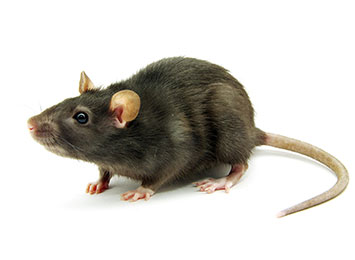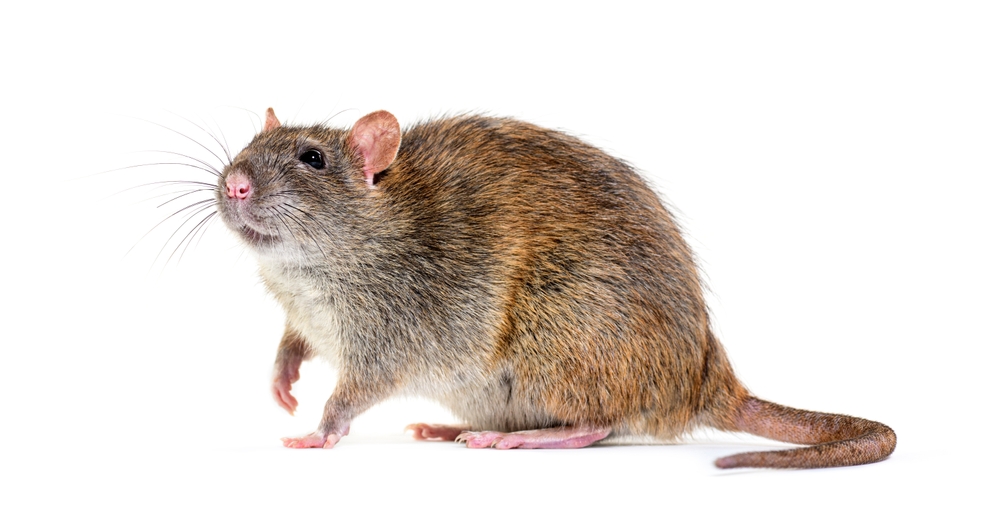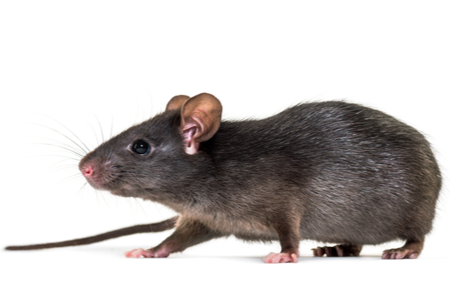- Size: Rats are medium-sized rodents, about 10-12,” that seldom weigh over a pound.
- Color: Generally brown or gray, but they can be black.
Rat Control New York
NYC Rat Appearance

Rat Control, New York, New Jersey and Connecticut
Signs of a Rat Infestation
There are certain tell-tale signs of a rat infestation that can help you identify your problem. These include:
- Droppings
- Chew marks
- Holes
- Frayed cords
- Nests
- Grease marks
Rats leave behind cone-shaped, dark brown droppings wherever they live. Rats also constantly chew on surfaces such as cardboard, plastic, carpet or even wood, leaving behind distinctive bite marks. They can create holes in your walls and damage electronic equipment.
Rats build nests out of any soft material they can transport and collect including paper, insulation, cloth and cardboard. They’ll build these small, dirty nests in dark, cramped nooks and crannies or inside of walls. As they travel the grease on rat’s bodies can leave behind smudges on the walls.
NYC Rat Control and Prevention
Garbage
Start by protecting your garbage. Rats are attracted to all manner of smells and food leftovers. Keep cans and dumpsters closed and fastened shut whenever you aren’t using them. Take the garbage out to your dumpster every night, and keep it in sealed plastic bags. Clean your dumpster around once a month.
Openings
Secondly, seal the entry points where rats are getting in. Rodents like rats can enter cracks and gaps no larger than a dime. Typically, they find these gaps around cracked foundations, baseboards, utility line connections, ventilation, and roofing. Look for and seal any draft-producing gaps with caulk or fill with steel wool.
Rat Behavior and Diet
Rats are opportunistic omnivores. They’ll eat whatever they can find wherever they can find it, though they tend to prefer grains, fruits, vegetables, seeds, and nuts. They settle in areas with large quantities of food they can easily access.
Unlike mice, rats are not natural explorers. Instead, they tend to find and stick to pre-designated routes between their nests and food sources throughout a building. They often wear these routes down or leave behind trail markings over time.
Reproduction
Female rats typically give birth to eight to ten pups per litter with gestation lasting only 21 days. They can also mate and give birth up to seven times in a single year, making for a fast growing population.
Like other mammals, rats are born helpless and must be nursed by their mothers. However, rat babies quickly reach full sexual maturity in about five weeks. Upon reaching maturity, they will immediately seek out other mates. Rats live for up to three years in ideal circumstances, though they’ll often die sooner.
Other characteristics
- Rats instinctively avoid certain tastes and odors. However, no rat repellent has been discovered that eliminates an infestation.
- Because rats have poor eyesight, they rely primarily on their sense of smell and taste to discern their surroundings.
- Rats transmit a variety of diseases to humans and other animals (bacterial, protozoan and viral), parasites (worms) and ectoparasites (fleas, lice and mites).
Types of Rats in NYC
There are two types of New York rats. Size and population density are the main differences between them.

Norway Rat
The most common type of rat in New York, New Jersey and Connecticut is the Norway rat. Also known as the “brown rat” or more commonly the “NYC sewer rat,” these rodents are characterized by their flat snout, small ears and long pink tail. They are typically about 16-20” long, weigh around one pound and are brown or gray in color. When you see a rat in Queens or have a rat problem in Long Island, it’s usually Norway rats.

Black Rat
Black rats or “roof rats,” used to be more common in NYC but have been mostly wiped out by the more aggressive brown rat population. Black rats run smaller in size, typically 5-7” long and weighing between 2-8 ounces.
Rat Treatment and Removal
There are many strategies you can try to remedy your rat problem. New York residents usually go one of these common routes:
Rat Traps
There are many types of rat traps available commercially including snap traps, glue traps and live traps. Snap traps or the most humane and effective and kill instantaneously. Because rats don’t travel far from their comfort zone, set traps in areas where you’ve seen signs of activity. Bait your traps with smelly foods that will attract attention like peanut butter, fish or meat.
Rat Baits
Baits are tasty lures that contain poison. The problem with baits is that rats will eat them and then go die in some remote location, like in your walls. You may not see the dead rat, but you’ll smell it.
Pest Control for Rats
The most reliable way to rid your space of rats and ensure that they don’t return is by hiring a professional New York pest control company like Assured. We can create an effective plan for eliminating rats and identify how they got in to prevent future infestation. Assured is the rat exterminator NYC homeowners and business owners can trust for fast service.
More Information
NYC Health Rat Information Portal
Illinois Department of Public Health Norway Rats Prevention and Control fact sheet
Rat FAQ
What is rat grease?
Rats have an oily coating on their fur. When they repeatedly travel over the same path, this oil can rub off on baseboards and walls, leaving a “grease trail.” Noticing these stains is a sure sign that you have a rat problem.
What does rat poop look like?
Rat poop is small round pellets that are brown or yellow. Newer poop will be shiny while older poop will turn gray and be dustier. An average rat makes 30-50 droppings/day so, you’re likely to see many.
How big can a rat get?
Rats typically get around one foot long, not including the tail. The largest rat in the world is the Gambian pouched rat which can weigh up to nine pounds and be nearly three feet long. And you thought we had large rats in New York!
How high can a rat jump?
Rats are surprisingly gifted jumpers. They are capable of jumping three feet vertically and four feet horizontally. Your countertops are not safe so keep food sealed in tight containers.
Can a rat swim?
Yes. Rats are strong swimmers that can stay above water for extended periods. They can also hold their breaths for up to three minutes. A drowned rat is not as easy to come by as you might think.
How long can a rat live without food?
Rats can go several days to a week without food as long as they have water. However, rats are hoarders and starving a rat is not necessarily easy if they have a stash hidden away.

